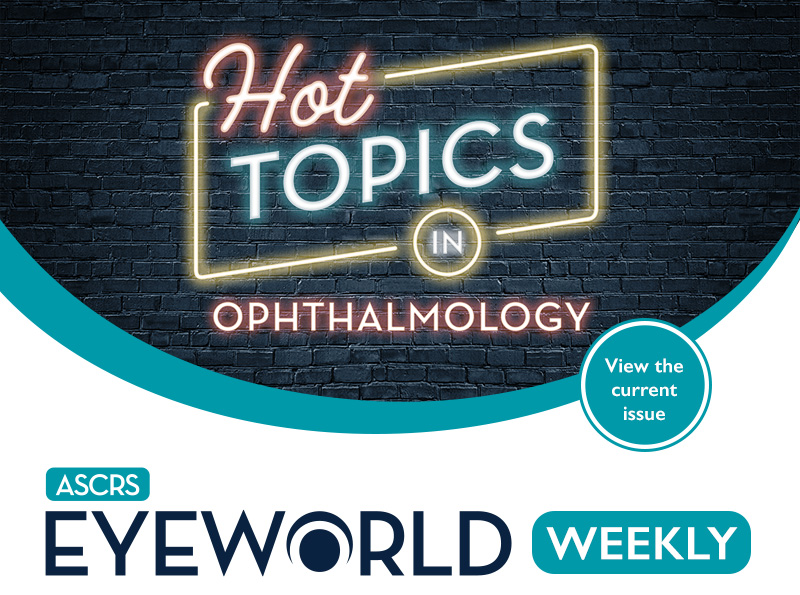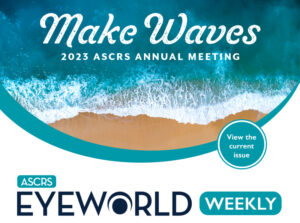
- NDA submitted for sustained-release travoprost implant
- BLA for wet AMD, DME, DR treatment accepted with priority review
- Topline results from 12-month safety clinical trial for investigational dry eye drug
- Companies collaborate for research on sustained release for investigational GA drug
- ASCRS news and events
March 3, 2023 • Volume 29, Number 9
NDA submitted for sustained-release travoprost implant
Glaukos announced its NDA submission for iDose TR to the FDA. iDose TR is a travoprost intraocular implant, designed to provide an alternative to prostaglandin analog drops for IOP lowering. The implant, which is implanted in a minimally invasive procedure, according to the company, is designed to be removed and replaced with a new iDose, when needed. According to the press release, the NDA is based on two Phase 3 pivotal trials, both of which met primary efficacy endpoints through 3 months and showed favorable safety and tolerability for 12 months. The NDA also includes data from the company’s iDose TR exchange trial, in which a second iDose was administered after removal of the first; this also showed a favorable safety profile, the company reported.
BLA for wet AMD, DME, DR treatment accepted with priority review
Regeneron Pharmaceuticals announced FDA acceptance of its Biologics License Application (BLA) for aflibercept 8 mg for treatment of wet AMD, DME, and diabetic retinopathy (DR). The FDA granted priority review with a target action date of June 27. According to the company’s press release, this BLA is supported with data from two pivotal trials that met primary endpoints of non-inferiority in visual gains at 12- and 16-week dosing regimens (after initial monthly doses) at 48 weeks, compared to an 8-week dosing regimen with EYLEA (aflibercept 2 mg, Regeneron). The safety profile of aflibercept 8 mg was similar to EYLEA in both trials. According to the company, aflibercept 8 mg is being jointly developed by Regeneron and Bayer, with Regeneron maintaining rights to EYLEA and aflibercept 8 mg in the U.S. and Bayer licensing marketing rights outside of the U.S.
Topline results from 12-month safety clinical trial for investigational dry eye drug
Aldeyra Therapeutics announced topline results from its 12-month, vehicle-controlled, multicenter, parallel-group safety clinical trial of reproxalap for treatment of dry eye disease. There were no treatment-related serious adverse events involving ocular safety among any patients; ocular safety events were similar in both the reproxalap and vehicle groups. According to the company’s press release, post-hoc analysis showed a statistically superior improvement in distance visual acuity from baseline in the reproxalap group. More specifically, the reproxalap group’s distance vision improved from 20/27 to 20/24, according to the company. The safety trial included 447 patients with dry eye disease (299 received reproxalap, 148 vehicle).
Companies collaborate for research on sustained release for investigational GA drug
EyePoint Pharmaceuticals and Rallybio Corporation announced their collaboration to evaluate sustained delivery of Rallybio’s investigational C5 inhibitor for treatment of geographic atrophy (GA) using EyePoint’s Durasert technology for sustained, intraocular drug delivery with the goal of reducing the need for intravitreal injections. Durasert is already FDA approved as a modality for sustained release of pharmaceuticals for chronic, non-infectious uveitis affecting the posterior segment, DME, uveitis, and CMV retinitis.
ASCRS news and events
- ASCRS Annual Meeting: Registration for the ASCRS Annual Meeting, May 5–8, 2023, in San Diego, California, is ongoing. “Make Waves” in education, innovation, and networking specifically focused on anterior segment surgery. The Tier 2 registration deadline is March 29.
- ASCRS Annual Meeting Preview Program: The ASCRS Annual Meeting Preview Program is available online with details about Annual Meeting schedules and programming.
- Eyecelerator: Registration is open for Eyecelerator @ ASCRS 2023. The innovation conference from ASCRS and the American Academy of Ophthalmology will be held on May 4 in San Diego, California. Join investors, industry leaders, and ophthalmologists at this showcase of companies, technology, and other exciting innovation topics in ophthalmology.
Research highlights
- Patient-reported visual outcomes of immediately sequential bilateral cataract surgery (ISBCS) compared to delayed sequential bilateral cataract surgery (DSBCS) was the subject of a prospective, observational cohort study published in the Journal of Cataract & Refractive Surgery. The study administered a Catquest-9SF questionnaire on the day of surgery for ISBCS patients (n=152) and on the day of first-eye surgery for DSBCS (n=34) patients. The same survey was given to ISBCS patients 1 month after surgery and to DSBCS patients 1 month after each eye’s surgery. The researchers found that ISBCS patients had a significantly lower Catquest-9SF score compared to DSBCS patients after first-eye surgery. The ISBCS group had better scores in reading newsprint and text on the television, in addition to other visual tasks. When compared to scores 1 month after second-eye surgery for the DSBCS group, patients in both groups achieved similar Catquest-9SF scores. The authors concluded that ISBCS patients had “significantly greater perceived visual function and fewer vision-related limitations in their daily activities at 1 month,” but the “difference lost significance 1 month after second-eye surgery of DSBCS patients.” The authors reported no evidence of perceived bilateral visual impairment in the early postop period in the ISBCS group.
- A retrospective comparative study published in the journal Clinical Ophthalmology evaluated performance and intraoperative complication rates upon resuming cataract surgery after the shutdown of elective surgeries in the early stage of the COVID-19 pandemic. The study analyzed surgeries from Wayne State University, Detroit, Michigan, from January 1–March 18, 2020 (pre-shutdown) and from May 11–July 31, 2020 (post-shutdown). The authors reported that no prior studies had compared success or intraoperative complications of cataract surgery pre- and post-pandemic shutdown. The study included 480 cases (306 pre-shutdown and 174 post-shutdown). The study authors reported a significantly higher frequency of complex cataract surgeries post-shutdown but noted that surgical complication rates were not statistically significant among the two groups. Residents who were surveyed reported feeling concerned about performing phacoemulsification when returning to the OR. Anxiety of returning to surgery after 2 months did not lead to surgical complications, the authors reported.
This issue of EyeWorld Weekly was edited by Stacy Jablonski, Liz Hillman, and Ellen Stodola.
EyeWorld Weekly (ISSN 1089-0319), a digital publication of the American Society of Cataract and Refractive Surgery (ASCRS), is published every Friday, distributed by email, and posted live on Friday.
Medical Editors: Sumit “Sam” Garg, MD, Chief Medical Editor, Mitchell Weikert, MD, Cataract Editor, Karolinne Rocha, MD, PhD, Refractive Editor, Julie Schallhorn, MD, Cornea Editor, Manjool Shah, MD, Glaucoma Editor
For sponsorship opportunities or membership information, contact: ASCRS • 12587 Fair Lakes Circle • Suite 348 • Fairfax, VA 22033 • Phone: 703-591-2220 • Fax: 703-591-0614 • Email: ascrs@ascrs.org
Mention of products or services in EyeWorld Weekly does not constitute an endorsement by ASCRS.
Click here to view our Legal Notice.
Copyright 2023, EyeWorld News Service. All rights reserved.


